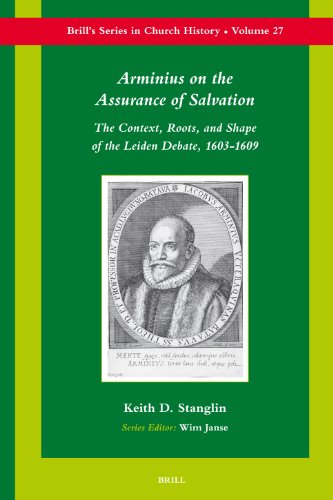Arminius on the Assurance of Salvation: The Context, Roots, and Shape of the Leiden Debate, 1603–1609
Written by Keith D. Stanglin Reviewed By Thomas H. McCallAs Keith D. Stanglin points out, it is amazing that “a figure who was so influential and controversial in his own day and continues to be invoked in a variety of theological and ecclesiastical communities in our day has nevertheless received such slight attention from historians” (p. xiii). Despite the fact that many Christians are called “Arminians” even into the twenty-first century, there is precious little work that helps us understand who Arminius was and just what the controversies were all about. Both defenders and detractors of “Arminianism” often proceed with woefully ill-informed notions of the issues and persons involved, and far too much of the available secondary literature perpetuates misunderstandings. Stanglin sets himself to the task of addressing the need for careful scholarly attention to Arminius, and Arminius on the Assurance of Salvation is a significant step forward.
Stanglin first notes this lack of reliable scholarship on Arminius. He sets aside immediately the “Arminius of mythical lore,” either the “free thinking, enlightened hero who put his Calvinist oppressors in their place with his irrefutable biblical theology” or “the deceptive heretic who resurrected Pelagianism and made anthropocentric religion, Enlightenment rationalism, and anti-Trinitarianism acceptable” (p. 1). Pointing out that responsible scholarship must both use the appropriate sources (and not only those conveniently translated into English) and contextualize Arminius, Stanglin interprets Arminius as a scholastic theologian who was working with what were then the standard tools of the trade while attempting to be both pastorally sensitive and faithful to Scripture.
Stanglin then sets Arminius within the early seventeenth-century theological context (specifically in the Staten College at the University of Leiden and particularly in conversation with Franciscus Gomarus, Lucas Trelcatius Jr., and Johannes Kuchlinus). He locates areas of agreement with his Reformed contemporaries, and he observes as well the areas of disagreement. Stanglin rightly observes that the real and important points of disagreement came not in the understandings of the human condition but rather with respect to the understandings of grace. Arminius ascribes to God’s grace “the origin, the continuance, and the fulfillment of all good,” and he denies that anyone can think, will, or do anything good apart from divine grace (p. 80). The real and important difference, then, concerns this divine grace: “the only difference is located here, whether God’s grace be an irresistible force” (p. 81).
After noting the continuities and discontinuities regarding grace, predestination (especially that there is “no meaningful differences” regarding justification), sanctification, perfection, and apostasy, Stanglin moves to the heart of his discussion: the topic of assurance. While some latter-day partisans in the debates over “Calvinism” and “Arminianism” may question whether Arminius even had a doctrine of assurance, Stanglin argues that it was a driving force in his theology. He was deeply concerned with what he saw as the logical outcome of the Reformed account of election and reprobation. He was exercised to avoid both desperatio and securitas(understood as carelessness), and he was convinced that any theology should avoid these extremes and find certitudo (p. 195). As for the grounds of this assurance, there are two major grounds for it: the a posteriori (the sensus fidei and the testimony of the Holy Spirit, the wrestling or lucta and the good works that are the result of justification) and the a priori (which for the Reformed are in God’s inscrutable decree). Arminius does not differ from the Reformed regarding the a posteriori conditions, but he takes leave regarding the a priori. For all of this is, on Arminius’s account, founded upon the duplex amor: the love of God for himself and righteousness, and the love of God for creatures and their blessedness (p. 219).
I can hardly say enough good about this book. Stanglin engages the sources (both primary and secondary, in Latin, Dutch, and French as well as English), places Arminius squarely within his immediate social and theological context, and clearly explains his thought as it developed in the context of a pastorally-sensitive scholastic theology. It deserves a place right alongside Richard A. Muller’s groundbreaking and important God, Creation, and Providence in the Thought of Jacob Arminius: Sources and Directions in Scholastic Protestantism in the Era of Early Orthodoxy (Grand Rapids: Baker, 1991). To understand Arminius on salvation or, more generally, Reformed theology at Leiden during this period, this is the best resource available.
Thomas H. McCall
Thomas H. McCall
Trinity Evangelical Divinity School
Deerfield, Illinois, USA
Other Articles in this Issue
I didn’t come from an Evangelical home, and though he never told me outright, I’m sure my father never wanted me to become a pastor...
Does Baptism Replace Circumcision? An Examination of the Relationship between Circumcision and Baptism in Colossians 2:11–12
by Martin SalterReformed paedobaptists frequently cite Col 2:11–12 as evidence that baptism replaces circumcision as the covenant sign signifying the same realities...
New Commentaries on Colossians: Survey of Approaches, Analysis of Trends, and the State of Research
by Nijay GuptaNew Testament scholarship in its present state is experiencing a time of abundance, especially with respect to biblical commentaries of every shape, length, level of depth, theological persuasion, intended audience, and hermeneutical angle...
It might seem odd to write an editorial for a theological journal on the topic of not doing theology and how important that can be; and, indeed, perhaps it is contrarian even by my own exacting standards...
Most readers of Themelios will be aware that the word “perfectionism” is commonly attached in theological circles to one subset of the Wesleyan tradition...







